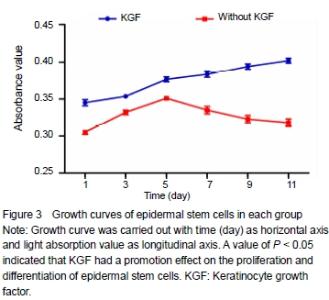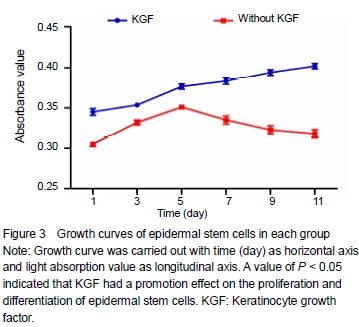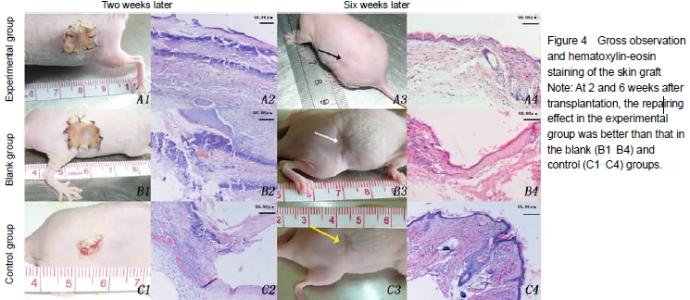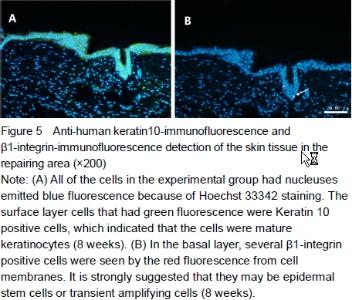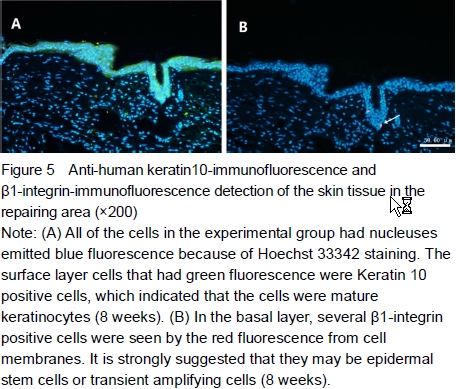Chinese Journal of Tissue Engineering Research ›› 2015, Vol. 19 ›› Issue (42): 6746-6752.doi: 10.3969/j.issn.2095-4344.2015.42.005
Previous Articles Next Articles
Repairing skin defects in nude mice using tissue-engineered skin loading keratinocyte growth factor nanocapsules
Li Bing-hang1, 2, Deng Li-huan1, Xiang Meng-juan1, Yang Bin1, 2
- 1 Digital Simulation Center, Plastic Surgery Hospital, Chinese Academy of Medical Science and Peking Union Medical College, Beijing 100144, China
2 Department of Maxillofacial Surgery, Plastic Surgery Hospital, Chinese Academy of Medical Science and Peking Union Medical College, Beijing 100144, China
-
Online:2015-10-08Published:2015-10-08 -
Contact:Yang Bin, M.D., Professor, Chief physician, Doctoral supervisor, Digital Simulation Center, Plastic Surgery Hospital, Chinese Academy of Medical Science and Peking Union Medical College, Beijing 100144, China; Department of Maxillofacial Surgery, Plastic Surgery Hospital, Chinese Academy of Medical Science and Peking Union Medical College, Beijing 100144, China -
About author:Li Bing-hang, Studying for master’s degree, Digital Simulation Center, Plastic Surgery Hospital, Chinese Academy of Medical Science and Peking Union Medical College, Beijing 100144, China; Department of Maxillofacial Surgery, Plastic Surgery Hospital, Chinese Academy of Medical Science and Peking Union Medical College, Beijing 100144, China -
Supported by:the National Natural Science Foundation of China, No. 30772099; the Natural Science Foundation of Beijing, No. 7112111
Cite this article
Li Bing-hang, Deng Li-huan, Xiang Meng-juan, Yang Bin. Repairing skin defects in nude mice using tissue-engineered skin loading keratinocyte growth factor nanocapsules[J]. Chinese Journal of Tissue Engineering Research, 2015, 19(42): 6746-6752.
share this article
| [1] Yang B, Hong QQ, Qiu RS, et al. Fast reconstruction of compostite tissue-engineered skin in vitro. Zhongguo Xiufu Chongjian Waike Zazhi. 2007;21:406-410.
[2] Cao YL, Cai X, Cui L, et al. Repair of porcine full-thickness skin defects with autologous tissue engineered skin. Zhonghua Waike Zazhi. 2002;40:24-26.
[3] Yang GH, Cui L, Liu W, et al. Repairment of full-thickness wounds utilizing tissue engineering techniques. Zhonghua Shiyan Waike Zazhi. 2003;20:408-410.
[4] Eaglstein WH, Alvares OM, Auletta M, et al. Acute ecxisional wounds treated with a tissue-engineered skin (Apligraf). Dermatol Surg. 1999;25:195.
[5] Cotsarelis G, Kaur P, Dhouailly D, et al. Epithelial stem cells in the skin: definition , markers, localization and functions. Exp Dermatol. 1999;8:80-88.
[6] Morasso I, Marjana TC. Epidermal stem cells: the cradle of epidermal determination, differentiation and wound healing, Biol Cell. 2005;97(3):173-183.
[7] Michel M, Torok N, Godbout MJ, et al. Keratin 19 as a biochemical marker of skin stem cells in vivo and in vitro: keratin 19 expressing cells are differentially localized in function of anatomic sites, and their number varies with donor age and culture stage. J Cell Sci. 1996;109: 1017-1028.
[8] Raghavan S, Bauer C, Mundschau G, et al. Conditional ablation of beta1 integrin in skin. Severe defects in epidermal proliferation, basement membrane formation, and hair follicle invagination. J Cell Biol. 2000;150(5): 1149-1160.
[9] Kaur P, Li A. Adhesive properties of human basal epidermal cells: an analysis of keratinocyte stem cells, transit amplifying cells, and postmitotic differentiating cells. J Invest Dermatol. 2000;114:413-420.
[10] Yang B, Hong QQ, Xu L, et al. A Study on rapid and efficient separation of epidermal stem cell. Zuzhi Gongcheng yu Chongjian Waike Zazhi. 2005;1(5):268-271.
[11] Yang B, Hong QQ, Xu L, et al. Fast harvest of seed cells for composite tissue engineered skin at one time. Zhongguo Xiufu Chongjian Waike Zazhi. 2006;20(7):754-757.
[12] Andreadis ST, Hamoen KE, Yarmush ML, et al. Keratinocyte growth factor induces hyperproliferation and delays differentiation in a skin equivalent model system. FASEB J. 2001;15:898-906.
[13] Pan ZZ, Devaux Y, Ray P. Ribosomal S6 kinase as a mediator of KGF induced activation of Akt in epithelial cells. Molecul Biol Cell. 2004;15:3106-3113.
[14] Kopp J, Guang YW, Peter K, et al. Accelerated wound healing by in vivo application of keratinocytes overexpressing KGF. Mol Ther. 2004;10(1):86-96.
[15] Farrell CL, Rex KL, Chen JN, et al. The effects of keratinocyte growth factor in preclinical models of mucositis. Cell Prolif. 2002;35(Suppl 1):78-85.
[16] Melissa J, Mc G, Sun D, et al. Epidermal growth factor-induced cell proliferation in the dult rat striatum. Brain Res. 2004;1007:29-38.
[17] Yang B, Qiu RS, Quan DP, et al. Construction and characteristics of acellular dermal matrix loaded with keratinocyte growth factor nanocapsules and its effects on the growth of epidermal stem cells. Zhongguo Zuzhi Gongcheng Yanjiun yu Linchuang Kangfu. 2007;11(18): 3551-3554.
[18] Kopp J, Wang GY, Kulmburg P, et al. Accelerated wound healing by in vivo application of keratinocytes overexpressing KGF. Mol Ther. 2004;10(1):86-96.
[19] Witte RP, Kao WJ. Keratinocyte-fibroblast paracrine interaction: the effects of substrate and culture condition. Biomaterials. 2005;26(17):3673-3682.
[20] Schwarz C, Mehnert W. Solid lipid nanoparticles (SLN) for controlled drug delivery. II. Drug incorporation and physicochemical characterization. J Microencapsul 1999; 16(2):205-213.
[21] Song CX. Formulation and characterization of biodegradable nanoparticles for intravascular local drug delivery. J Control Release. 1997;43:197-212.
[22] Wainwright DJ. Use of an acellulor allogroft dermal matrix (Alloderm) in the management of full-thickness burns. Burns. 1995;21(4):243.
[23] Rnnekampff HO. Acellular human dermis promotes cultured keratinote engraftment. J Burn Care Rehabil. 1997;18(6):535.
[24] Watt FM. Epidermal stem cells: markers, patterning and the control of stem cell fate. Philos Trans R Soc Lond B Biol Sci. 1998;353(1370):831-837.
[25] Bader RA, Kao WJ. Modulation of the keratinocyte-fibroblast paracrine relationship with gelatin-based semi-interpenetrating networks containing bioactive factors for wound repair.J Biomater Sci Polym Ed. 2009;20(7-8):1005-1030.
[26] Ceccarelli S, Cardinali G, Aspite N, et al. Cortactin involvement in the keratinocyte growth factor and fibroblast growth factor 10 promotion of migration and cortical actin assembly in human keratinocytes. Exp Cell Res. 2007;313(9):1758-77.
[27] Marti GP, Mohebi P, Liu L, et al. KGF-1 for wound healing in animal models. Methods Mol Biol. 2008;423:383-391. |
| [1] | Pu Rui, Chen Ziyang, Yuan Lingyan. Characteristics and effects of exosomes from different cell sources in cardioprotection [J]. Chinese Journal of Tissue Engineering Research, 2021, 25(在线): 1-. |
| [2] | Lin Qingfan, Xie Yixin, Chen Wanqing, Ye Zhenzhong, Chen Youfang. Human placenta-derived mesenchymal stem cell conditioned medium can upregulate BeWo cell viability and zonula occludens expression under hypoxia [J]. Chinese Journal of Tissue Engineering Research, 2021, 25(在线): 4970-4975. |
| [3] | Zhang Tongtong, Wang Zhonghua, Wen Jie, Song Yuxin, Liu Lin. Application of three-dimensional printing model in surgical resection and reconstruction of cervical tumor [J]. Chinese Journal of Tissue Engineering Research, 2021, 25(9): 1335-1339. |
| [4] | Li Jing, Xie Jianshan, Cui Huilin, Cao Ximei, Yang Yanping, Li Hairong. Expression and localization of diacylglycerol kinase zeta and protein kinase C beta II in mouse back skin with different coat colors [J]. Chinese Journal of Tissue Engineering Research, 2021, 25(8): 1196-1200. |
| [5] | Zhang Xiumei, Zhai Yunkai, Zhao Jie, Zhao Meng. Research hotspots of organoid models in recent 10 years: a search in domestic and foreign databases [J]. Chinese Journal of Tissue Engineering Research, 2021, 25(8): 1249-1255. |
| [6] | Hou Jingying, Yu Menglei, Guo Tianzhu, Long Huibao, Wu Hao. Hypoxia preconditioning promotes bone marrow mesenchymal stem cells survival and vascularization through the activation of HIF-1α/MALAT1/VEGFA pathway [J]. Chinese Journal of Tissue Engineering Research, 2021, 25(7): 985-990. |
| [7] | Shi Yangyang, Qin Yingfei, Wu Fuling, He Xiao, Zhang Xuejing. Pretreatment of placental mesenchymal stem cells to prevent bronchiolitis in mice [J]. Chinese Journal of Tissue Engineering Research, 2021, 25(7): 991-995. |
| [8] | Liang Xueqi, Guo Lijiao, Chen Hejie, Wu Jie, Sun Yaqi, Xing Zhikun, Zou Hailiang, Chen Xueling, Wu Xiangwei. Alveolar echinococcosis protoscolices inhibits the differentiation of bone marrow mesenchymal stem cells into fibroblasts [J]. Chinese Journal of Tissue Engineering Research, 2021, 25(7): 996-1001. |
| [9] | Fan Quanbao, Luo Huina, Wang Bingyun, Chen Shengfeng, Cui Lianxu, Jiang Wenkang, Zhao Mingming, Wang Jingjing, Luo Dongzhang, Chen Zhisheng, Bai Yinshan, Liu Canying, Zhang Hui. Biological characteristics of canine adipose-derived mesenchymal stem cells cultured in hypoxia [J]. Chinese Journal of Tissue Engineering Research, 2021, 25(7): 1002-1007. |
| [10] | Geng Yao, Yin Zhiliang, Li Xingping, Xiao Dongqin, Hou Weiguang. Role of hsa-miRNA-223-3p in regulating osteogenic differentiation of human bone marrow mesenchymal stem cells [J]. Chinese Journal of Tissue Engineering Research, 2021, 25(7): 1008-1013. |
| [11] | Lun Zhigang, Jin Jing, Wang Tianyan, Li Aimin. Effect of peroxiredoxin 6 on proliferation and differentiation of bone marrow mesenchymal stem cells into neural lineage in vitro [J]. Chinese Journal of Tissue Engineering Research, 2021, 25(7): 1014-1018. |
| [12] | Zhu Xuefen, Huang Cheng, Ding Jian, Dai Yongping, Liu Yuanbing, Le Lixiang, Wang Liangliang, Yang Jiandong. Mechanism of bone marrow mesenchymal stem cells differentiation into functional neurons induced by glial cell line derived neurotrophic factor [J]. Chinese Journal of Tissue Engineering Research, 2021, 25(7): 1019-1025. |
| [13] | Duan Liyun, Cao Xiaocang. Human placenta mesenchymal stem cells-derived extracellular vesicles regulate collagen deposition in intestinal mucosa of mice with colitis [J]. Chinese Journal of Tissue Engineering Research, 2021, 25(7): 1026-1031. |
| [14] | Pei Lili, Sun Guicai, Wang Di. Salvianolic acid B inhibits oxidative damage of bone marrow mesenchymal stem cells and promotes differentiation into cardiomyocytes [J]. Chinese Journal of Tissue Engineering Research, 2021, 25(7): 1032-1036. |
| [15] | Guan Qian, Luan Zuo, Ye Dou, Yang Yinxiang, Wang Zhaoyan, Wang Qian, Yao Ruiqin. Morphological changes in human oligodendrocyte progenitor cells during passage [J]. Chinese Journal of Tissue Engineering Research, 2021, 25(7): 1045-1049. |
| Viewed | ||||||
|
Full text |
|
|||||
|
Abstract |
|
|||||




